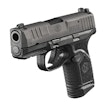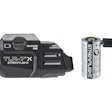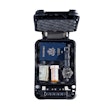It was a dark night in the desert and it was one of those unknown trouble calls. Phoenix (Ariz.) Police Officer Paul Hubert and his K-9 partner Ranger approached the front of a single story building, which had several windows and doors, searching for an armed suspect or suspects.
As they were passing one of the windows, an armed suspect suddenly appeared, facing Hubert and his partner. Hubert quickly fired two rounds from his sidearm, striking the suspect in the chest. Throughout the incident, Ranger was at his partner's side, in control and ready to deploy if needed.
That was only one of the scenarios encountered by officers and K-9s from about 12 different Arizona agencies, during the First Annual Advanced K-9 Firearms Seminar in Tucson, Ariz. The seminar was hosted by the Tucson Police Department, the Phoenix Police Department, the Pima County Sheriff's Office and the Arizona Law Enforcement Canine Association (A.L.E.C.A.). A.L.E.C.A. is an organization of law enforcement K -9 handlers and trainers, based in Arizona, that has set voluntary performance standards for K-9 teams and sponsors K-9 trainings and trials all over the state.
A.L.E.C.A. President Sgt. Carl Lewis, of the Tucson Police Department, said the event was successful, as there was plenty of time for one-on-one training and for participants to repeat scenarios.
The two-day seminar at the Tucson Public Safety training facility featured classroom lectures covering target acquisition, reloading and shotgun deployment. After a basic qualification course, the handlers and K-9s went through several different training scenarios that focused on proper tactics/shooting skills and K-9 reaction in shooting and tactical situations.
Correcting Problems Through Training in Realistic Scenarios
As a handler, though you should not bring a dog to a gunfight, you need to know how your dog will react to gunfire - and not while you're in the field on a call, but during training. You should give your K-9 partner the same advantage you have, through realistic training. Drawing on years of experience and a sense of "see it here before you see it on the street," seminar instructors designed the training to test the handler and the K9 partner in various real-life situations.
During the seminar, behavior was observed in a couple of the K -9s that needed to be addressed, which is the purpose of the training. Lasting corrective behavior is probably not going to be completed in one or two nights, but the experience of the instructors provided some valuable insight to training ideas and alternatives.
The most commonly observed problems in this type of training involve dogs who are either "gun shy" or gunfire aggressive. In either situation, it is a control problem that can have disastrous results for the handler or his K-9 partner.
In a gun-shy dog, the behavior of the dog is to run or pull away from the gunfire. After a certain amount of time, just the sight of your sidearm may cause the dog to react this way. On the other hand, a gun-aggressive dog will lunge towards the suspect, handler or the gun. I have seen several dogs actually try to bite the gun out of the handler's hand - a safety issue from several viewpoints, to say the least.
With both types of behavior, some of the same training techniques may help. It pays to introduce your K-9 to guns and gunfire slowly. It's probably best not to take your K -9 partner on a long, drawn out qualification shoot. It will only be a matter of time before the dog gets stressed and starts exhibiting some behavior problems.
A better approach might be to use a blank gun with a smaller load than your sidearm. You could also conduct drills in which you just pull Your gun and present it, then holster it.
When practicing with firearms, earplugs are certainly a consideration. If you need them, it's a given that your K9 partner needs them to protect sensitive hearing. Foam earplugs are carried by several veterinary suppliers.
Do Your Commands Translate?
Ideally, the dog will remain in a heel position and under control. It is difficult enough to engage a target in a critical incident without worrying about what your K-9 is doing. If you yell a challenge to a suspect, is your K-9 going to attempt to apprehend the suspect? Be sure of your commands and the K-9's reaction.
One of the scenarios required the handler to deploy his K-9 on a high-risk traffic stop. In the training scenario, as in real life, the doors of the suspect vehicle were left open as the occupants were detained. From a position of cover, the K-9 was sent toward the vehicle and when abreast of the open door, was ordered in to clear it. This type of vehicle clearing work is fairly easy for the K-9 to learn. Make sure, however, that the command you give for vehicle clearing is different than the command you use to load up your K-9 in your vehicle. I have seen dogs get to the suspect vehicle, and the handler yells whatever command he uses to get the dog back in his car and the K -9 recalls and runs back to the patrol vehicle.
A police K-9 can be one of the best tools available on a high-risk stop - as long as the correct command is given.
Human Error
In the course of my own participation in another- scenario, I encountered a booby-trap situation during a building search. The "suspect" even let me know that the area was booby trapped. Assuming that my IOO-pound Russian shepherd Brigg, who was holding the suspect, was motivating his admissions, I moved in to check the area. Sure enough, the stairway was booby trapped. While I was patting myself on the back for finding the trip wire, I recalled my dog to my position - through the aforementioned trip wire, setting off the "device," thus ending the scenario and giving me something to think about.
Varied Scenarios
Other scenarios included a live-fire house, simunition house, assorted ranges and building fronts that simulate apartments, a bank and convenience store.
The use of a well-known interactive training simulator system provided yet another challenge for handlers and their K-9 partners. It was interesting to see the K-9s react to the suspects on the screen then check behind it, looking for the fleeing suspects who had been in view a moment before. These systems provide an outstanding training opportunity for you and your K-9 partner.
Virtually Reality
"It's better to have it happen here and learn horn it," said Sgt. Mike Cirivello, of the Coolidge (Arizona) Police Department. Cirivello added that the training was some of the best he has attended. He and his partner, Castor, participated in all the exercises and both gained experience in several deployment situations.
This type of training seminar reinforces several training philosophies that must be adhered to in order to keep a K-9 unit operating efficiently and safely: Keep your training as realistic as possible, maintain and document your required training hours, approach your training with the proper mindset, and take it seriously. Apply yourself as if your life depends on it.
It has been proven time and time again that in stress situations you revert back to what you have been trained. The old standby of a vacant, empty 1,100 square foot building search with one decoy does not cut it. How many burglaries have you investigated with multiple suspects? Training should reflect such scenarios, incorporate live-tire training and mirror the environment you work in.
This type of training can also head off several liability issues. If called upon in court or in a deposition, it is always preferable to have documented training with your K-9 partner in gunfire/tactical training scenarios. There is no way to foresee when a K-9 deployment can escalate to a shooting situation.
Pass the Info
Sharing of resources is of great value. It's a good idea to train with nearby agencies. No one has the market on K-9 training perfection and ideas you may have not heard about could help make your job safer and more effective.
The issues of proper K-9 deployments and good officer safety tactics are the same nationwide. Our hosts in Tucson did an outstanding job of providing realistic training that tested the abilities of the handlers and their partners and reinforced the officer survival mindset that is a necessity for all police officers. Stay safe.
For further information on this type of training write to A.L.E.C.A., PO. Box 3020-361 Chandler, Ariz. 85244.
Rod Mamero is a sergeant with the Payson (Ariz.) Police Department. He is an occasional contributor to POLICE.








